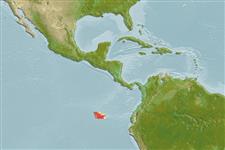Teleostei (teleosts) >
Perciformes/Serranoidei (Groupers) >
Anthiadidae (Fairy basslets or Streamer basses)
Etymology: Anthias: Greek, anthias, oy = a fish (Sparus aurata) (Ref. 45335); noeli: Named for Noel Archambault..
Environment: milieu / climate zone / depth range / distribution range
Ecology
Marine; reef-associated; non-migratory; depth range 184 - 351 m (Ref. 41254). Tropical; 1°N - 2°S, 93°W - 87°W
Southeast Pacific: Galapagos Islands.
Size / Weight / Age
Maturity: Lm ? range ? - ? cm
Max length : 29.0 cm TL male/unsexed; (Ref. 55763); common length : 20.0 cm TL male/unsexed; (Ref. 55763)
Dorsal spines (total): 10; Dorsal soft rays (total): 15 - 16; Anal spines: 3; Anal soft rays: 6 - 7; Vertebrae: 26. Sum of lateral-line scales plus total number of gillrakers, on individual specimens, 78 to 85; caudal fin lunate to deeply forked: dorsal, anal, pelvic, and caudal fins each with some produced soft rays; upper caudal-fin lobe longer than lower; anal fin angulated posteriorly; gular region without scales; endopterygoids and tongue without teeth (Ref. 41254).
Life cycle and mating behavior
Maturities | Reproduction | Spawnings | Egg(s) | Fecundities | Larvae
Anderson, W.D. Jr. and C.C. Baldwin, 2000. A new species of Anthias (Teleostei: Serranidae: Anthiinae) from the Galápagos Islands, with keys to Anthias and eastern Pacific Anthiinae. Proc. Biol. Soc. Wash. 113(2):369-385. (Ref. 41254)
IUCN Red List Status (Ref. 130435)
Threat to humans
Harmless
Human uses
Fisheries: of no interest
Tools
Special reports
Download XML
Internet sources
Estimates based on models
Preferred temperature (Ref.
123201): 5.7 - 13.8, mean 8.9 °C (based on 8 cells).
Phylogenetic diversity index (Ref.
82804): PD
50 = 0.5039 [Uniqueness, from 0.5 = low to 2.0 = high].
Trophic level (Ref.
69278): 3.6 ±0.5 se; based on size and trophs of closest relatives
Resilience (Ref.
120179): Medium, minimum population doubling time 1.4 - 4.4 years (Preliminary K or Fecundity.).
Fishing Vulnerability (Ref.
59153): Low vulnerability (19 of 100).
